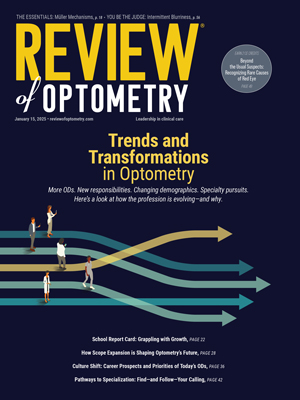When it comes to arteritic anterior ischemic optic neuropathy (A-AION) and non-arteritic AION (NA-AION), making the correct distinction at initial clinical presentation is critical, as the two conditions differ considerably in management. A-AION, associated with giant cell arteritis (GCA), also carries a graver visual prognosis compared with NA-AION. Harnessing the power of modern imaging techniques, a new study evaluated two promising OCT biomarkers that may help distinguish the A-AION from NA-AION at an early stage: paracentral acute middle maculopathy (PAMM) and peripapillary intraretinal and subretinal fluid (IRF/SRF). The findings, recently published in American Journal of Ophthalmology, are summarized below.
The study employed a nested prospective cross-sectional diagnostic accuracy design, analyzing OCT data from a small cohort of eight patients with A-AION and 24 with NA-AION, gathered from two prospective cross-sectional studies. The diagnosis of A-AION was confirmed through biochemical markers of inflammation, temporal artery biopsy and positron emission tomography/computed tomography, while NA-AION diagnosis was primarily based on neuroophthalmological expert assessment without clinical evidence or suspicion of A-AION.
PAMM was found exclusively in patients with A-AION, identified in 50% of cases, and showed a positive predictive value for GCA of 100%. The study authors stated in their paper that its presence is strongly indicative of an arteritic etiology, specifically linked to GCA, aligning with the hypothesis that PAMM in A-AION could represent focal ischemic damage within the middle retinal layers, which is characteristic of the arteritic nature of the condition.
| In a small cohort, PAMM was exclusively found in patients with A-AION, while peripapillary IRF/SRF extending into the macula within 3mm of the fovea was a finding exclusive to those with NA-AION. When combined, the two biomarkers could accurately classify AION based on OCT alone in three-quarters of cases. These images from the study show macular OCT scans in (A) a patient with arteritic AION and (B) one with non-arteritic AION. The first shows peripapillary paracentral acute middle maculopathy , while the second shows peripapillary intraretinal fluid that extends into the second ring of the fovea-centered ETDRS grid. The vertical green bar in image (B) delimits the leading edge of the intraretinal fluid. Photo: Klefter ON, et al. Am J Ophthalmol. December 5, 2024. Click image to enlarge. |
On the other hand, extensive IRF/SRF was prominent in NA-AION, observed in 83% of these cases but in no patients with A-AION. The authors noted in their paper, “The finding of peripapillary IRF/SRF extending into the macula within 3mm of the fovea suggests a non-arteritic etiology with a positive predictive value for NA-AION in our population of 100%.”
When combining these two biomarkers—the absence or presence of PAMM and the extension pattern of IRF/SRF—into the Early Treatment Diabetic Retinopathy Study grid, the researchers discovered that 75% of patients with AION could be accurately classified based on OCT alone.
“Combining these highly specific OCT findings might allow for early classification of the majority of patients with AION,” the researchers concluded, adding that “further studies are warranted to validate these findings with the purpose of providing clinicians with an important early diagnostic indicator.”
| Click here for journal source. |
Klefter ON, Hansen MS, Lykkebirk L, et al. Combining paracentral acute middle maculopathy and peripapillary fluid as biomarkers in anterior ischemic optic neuropathy. Am J Ophthalmol. December 5, 2024. [Epub ahead of print]. |


